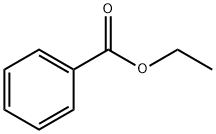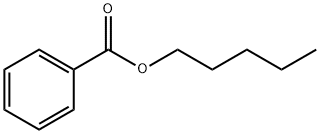Ethyl benzoate , StandardforGC,>99.5%(GC) , 93-89-0
Synonym(s):
Benzoic acid ethyl ester
CAS NO.:93-89-0
Empirical Formula: C9H10O2
Molecular Weight: 150.17
MDL number: MFCD00009109
EINECS: 202-284-3
| Pack Size | Price | Stock | Quantity |
| 5ML | RMB69.60 | In Stock |
|
| others | Enquire |
PRODUCT Properties
| Melting point: | -34 °C |
| Boiling point: | 212 °C(lit.) |
| Density | 1.045 g/mL at 25 °C(lit.) |
| vapor density | 5.17 (vs air) |
| vapor pressure | 1 mm Hg ( 44 °C) |
| FEMA | 2422 | ETHYL BENZOATE |
| refractive index | n |
| Flash point: | 184 °F |
| storage temp. | Store below +30°C. |
| solubility | 0.5g/l |
| form | Liquid |
| color | Clear colorless to pale yellow |
| Relative polarity | 0.228 |
| Odor | at 100.00 %. fruity dry musty sweet wintergreen |
| Odor Type | minty |
| biological source | synthetic |
| explosive limit | 1%(V) |
| Water Solubility | INSOLUBLE |
| Merck | 14,3766 |
| JECFA Number | 852 |
| BRN | 1908172 |
| Dielectric constant | 6.0(20℃) |
| Stability: | Stable. Combustible. Incompatible with strong oxidizing agents. |
| LogP | 2.59 at 23℃ |
| CAS DataBase Reference | 93-89-0(CAS DataBase Reference) |
| NIST Chemistry Reference | Benzoic acid, ethyl ester(93-89-0) |
| EPA Substance Registry System | Benzoic acid, ethyl ester (93-89-0) |
Description and Uses
Ethyl benzoate, C9H10O2, is the ester formed by the condensation of benzoic acid and ethanol. It is a colorless liquid that is almost insoluble in water, but miscible with most organic solvents.
As with many volatile esters, ethyl benzoate has a pleasant odor which could be described similar to wintergreen mint. It is a component of some artificial fruit flavors.
Ethyl benzoate is used as a perfume scent. It acts as a food flavoring agent. It is an active component of artificial fruit flavors. Further, it is used in cosmetics and personal care products as fragrance ingredients and preservatives.
Safety
| Symbol(GHS) |   GHS09,GHS07 |
| Signal word | Warning |
| Hazard statements | H411-H227-H303-H315-H319 |
| Precautionary statements | P210e-P280a-P305+P351+P338-P403+P235-P501a-P273 |
| Hazard Codes | N |
| Risk Statements | 51/53 |
| Safety Statements | 24/25-61 |
| RIDADR | UN 3082 9 / PGIII |
| WGK Germany | 1 |
| RTECS | DH0200000 |
| Autoignition Temperature | 914 °F |
| TSCA | Yes |
| HS Code | 29163100 |
| Toxicity | LD50 orally in rats: 6.48 g/kg, Smyth et al., Arch. Ind. Hyg. Occup. Med. 10, 61 (1954) |



